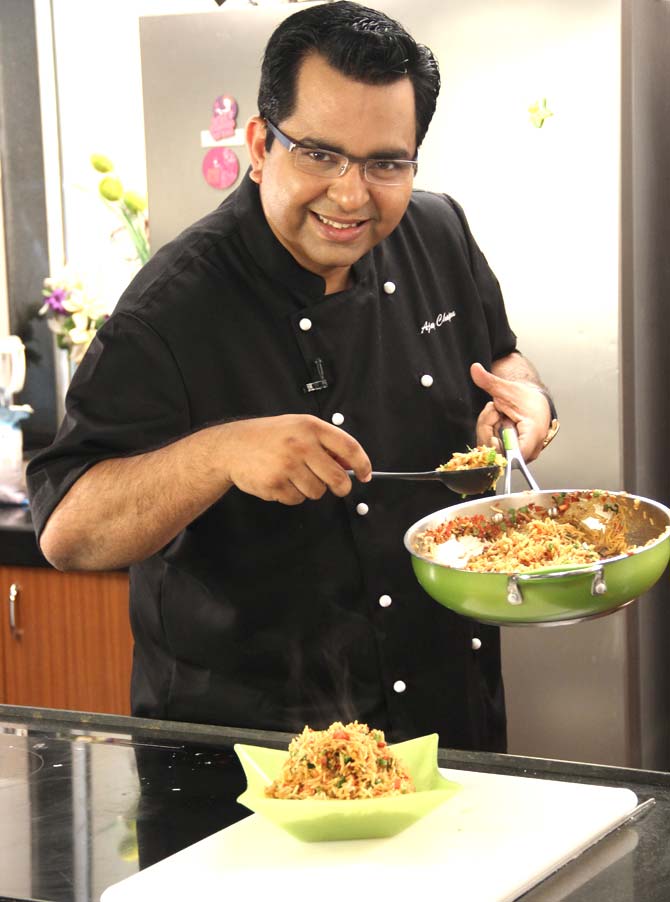This year will be the year chefs experiment with vegetables on your dinner plate. But, breathe easy, it's all natural

The no-carb spaghetti on the Craft menu boasts noodles made of grated raw papaya. It is their fastest-selling item. Natural flavour of food is 2016's big trend, says Romil Ratra
"Last week, a customer called saying he wanted to check if we could make a salad he’d tried in Germany," says chef Ajay Chopra, founder of Mumbai-based home-cooking kits Burgandy Box. This particular salad had watercress lettuce in it, an ingredient that Chopra is glad is easily available in the city.
ADVERTISEMENT

The no-carb spaghetti on the Craft menu boasts noodles made of grated raw papaya. It is their fastest-selling item. Natural flavour of food is 2016’s big trend, says Romil Ratra
The caller here isn’t alone in his interest in trying to locate a vegetable he liked. "People want to know what they are eating, where is it grown and how has it been treated. For the last 10 years, there has been a focus on local and seasonal produce in the West, which has also popularised the farm-to-table concept.

The output from First Agro’s 85 acre-farm in Narsipur Taluk, Mysore district, is 60-62 tonnes per harvest. Of this, 85 per cent is sold in Bengaluru, and the remaining produce goes to Mumbai, Delhi, Kolkata and Kochi
While every chef or restaurant cannot own farms, there are dedicated people who are doing a good job," says Chopra, who admits that India is yet to see a rise of farmers thinking out of the box. "Today, glocal produce (global crop grown locally), is abundant, and chefs are widely planning menus around it. For example, if there is fresh edamame, or a strain of roma tomatoes, I make sure they are on my menu. I am in touch with my supplier to know what crop is coming up, too."

Ajay Chopra
What Chopra doesn’t agree with is the demand for all vegetables year-round. "Our mothers never made gobi in the summers. It is not good for the digestive system. Similarly, gajar ka halwa is for winters. I am consciously adopting the methodology of desi khana."

Nameet M, First Agro
The art of plating and serving good-looking dishes is another reason vegetables, which come in all shapes and sizes, in different hues and textures, are the heroes of the dish today. Abhijit Saha of Bengaluru-based Avant Garde Hospitality, says, "It is our habit to follow the West, but weren't vegetables always the central focus for Indians? Now, we are seeing them in a new light. Or, should I say colour? " he laughs.
Saha, who owns restaurants Caperberry and Fava in Bengaluru, has been hosting a Veggies Chic festival for six years at caper. "We make every dish out of vegetables. For example, we once did a deconstructed vegetable paya in the form of a sushi," he says, adding, "Veggies and greens are versatile as they don’t not have sugar. People are beginning to scan and learn, and there is a balance in the demand-supply chain. Edible flowers and microgreens add excitement and freshness to the plate. They help create drama. For example, air drying vegetables can create crunchy chips. Vegetables are used to create rubs, coarse sauces, herbs."
Director at Craft, a deli at Phoenix Kurla Marketcity, Romil Ratra has a curious mind, and is always on the lookout for suppliers who take pride in their craft "Today, the palate wants to taste the vegetable. Diners don’t like too much spice and masala, which kills the purpose of eating vegetables. For this, we grow our own microgreens. Pluck them fresh, don’t store pesto but make it fresh for every order. The natural flavour of food is the trend this year, and so our veggies and fruits become heroes. They can make or break a dish."
One such dish on his menu is the no-carb spaghetti. "Spiralised raw squash and carrot is our interpretation of the noodle. This is our fastest selling item — wholesome, fresh and healthy."
He is currently busy working on his upcoming project, an Asian bistro called ShizuSan in Pune. "Here, we are going a step further. We are creating maki rolls with whole edible flowers. They have a natural flavour and each part of delicious."
Source well
While vegetables may be supreme to the dish, the taste depends on the quality of the source. Farrokh Khambata, owner of South Mumbai's fine-dining restaurants Joss, Amadeus and Umame, heavily relies on his source.
"A chef is always looking for good produce and I am ready to pay a premium for quality. We have done it for a few vegetables like oyster mushrooms, asparagus, tomatoes and potatoes. We even source organic eggs. The taste of fine-dining food is cleaner. For example, we used to import our camembert from France. Last year, the person I source my vegetables from suggested that I try an organic version of cheese from a woman in Kodaikanal. It changed the final taste of my dish, making it finer," says Khambata.
While people are health conscious, another reason for vegetables getting the much-needed attention is the pesticide and water used. "It has become a thing of principle," says Khambata.
Be the change
In 2011, when Nameet M, a commercial pilot in Canada, moved base to Bengaluru, the first question he asked was what would he feed his pregnant wife and unborn child. "What was the guarantee that the food was organic, safe and had no pesticide?"
He co-founded First Agro, India’s first commercial farm that pioneered the zero pesticide method of growing crops. Nameet is also reviving lost strains, and has a seed bank of 1,000, stored in refrigerators at the farm.
A grassroots man, Nameet feels chefs don’t value produce. "Ask a chef what is codex alimentarius, and he will not have an answer. It is the global standard defined by the UN to prevent intercity dispute, suggests an acceptable pesticide residue level. If you heard that export mangoes were rejected last year, that’s because it crossed its maximum residue limit," he says.
"Did you know tomatoes can be black in colour, and the original colour of cucumbers is purple? In tomatoes, we grow roma, mini roma, san marzano, which is the king of Italian tomatoes, 15 types of cherry tomatoes. Our specialties are heirloom varieties — 200-500 years old lost varieties collected from seed collectors and curators," says Nameet, whose output from their 85 acres in Narsipur Taluk, Mysore district, is 60-62 tonnes per month.
"We have 60 types of chillies, including jalapenos and Peruvian varieties. Lettuces include iceberg, romains, chiselled and Japanese. We also have 20 types of pumpkins. Did you know 50 years ago, the world had 280 varieties of cucumber? Today, we are down to 16. Farmers stopped growing them as people wanted the shiny, green ones."
While 85 per cent of his crop is sold in Bengaluru, the remaining produce goes to Mumbai, Delhi, Kolkata and Kochi.
"Chefs, I feel, need to be inspired to use less-known varieties. It makes no sense taking a black tomato and being clueless how to use it," he says, bluntly.
 Subscribe today by clicking the link and stay updated with the latest news!" Click here!
Subscribe today by clicking the link and stay updated with the latest news!" Click here!








